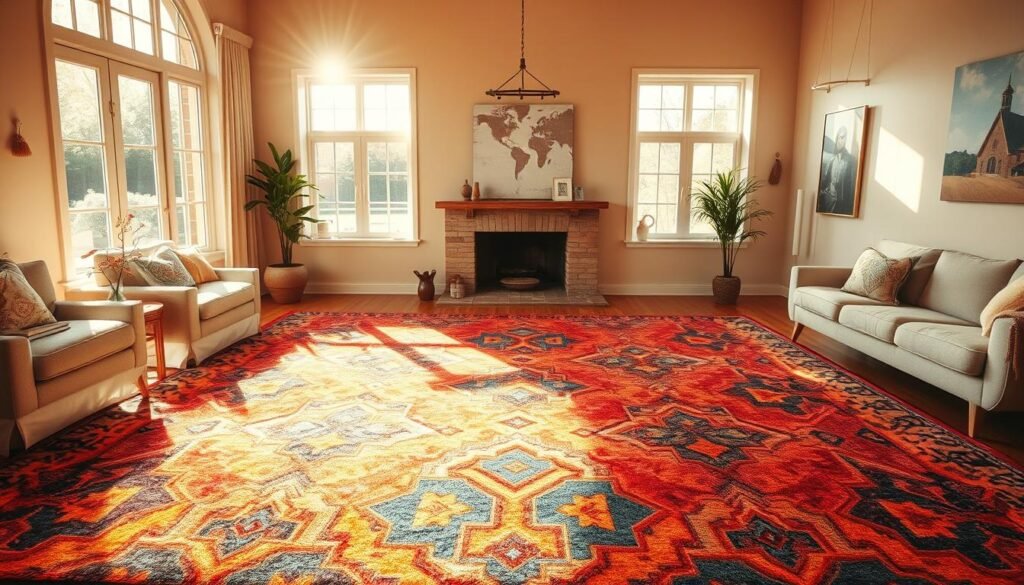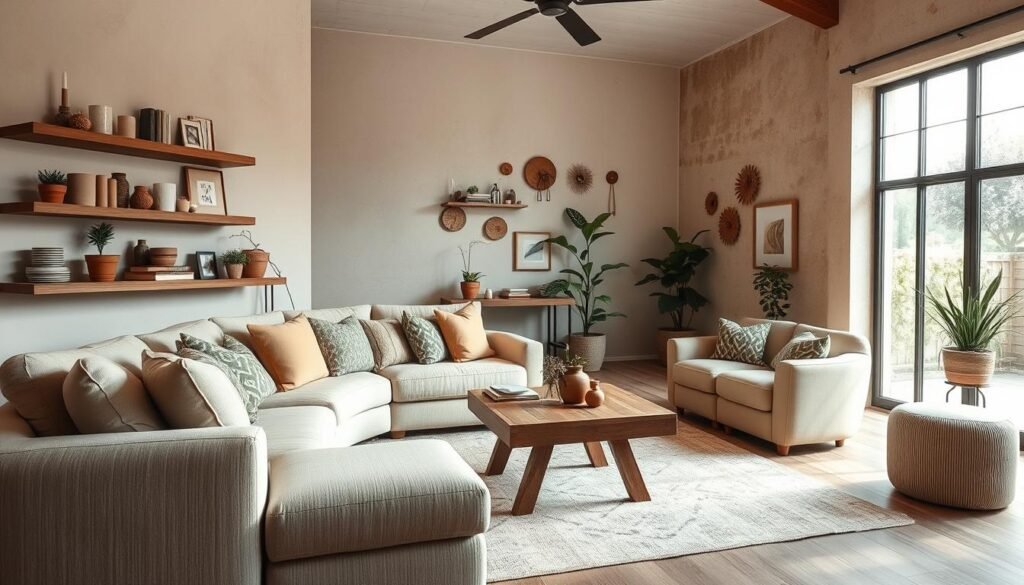Welcome to your go-to guide for creating a luxurious home space without the luxury price tag! Imagine walking into a room that feels polished, intentional, and effortlessly chic—no designer required. This article is all about turning that vision into reality using creativity, resourcefulness, and a few clever tricks.
You don’t need expensive furniture or a massive budget to make your home look high-end. Instead, focus on strategic upgrades that deliver maximum visual impact. From repurposing thrift-store finds to crafting custom accents, we’ll show you how to elevate your area with personality and flair.
Ready to dive in? Below, you’ll discover 10 achievable projects designed to add sophistication to any environment. These solutions work whether you’re a seasoned DIYer or just starting out. Best of all, they’re tailored to help you save money while creating a cohesive, magazine-worthy aesthetic.
Key Takeaways
- Luxury aesthetics are achievable through smart upgrades, not big budgets.
- DIY projects like upcycled furniture or handmade art add personalized elegance.
- Strategic use of lighting and textiles instantly elevates a room’s ambiance.
- Mixing textures and metallic accents creates depth and a curated feel.
- Small changes, like updating hardware or styling shelves, make outsized impacts.
Introduction to Budget-Friendly DIY Living Room Decor
Luxury-inspired interiors are within reach, even when working with a tight budget. Top designers prove that sophistication doesn’t require perfection—think relaxed spaces where cozy textiles mingle with metallic accents. The secret? It’s all about balancing visual weight and prioritizing pieces that spark joy.
Overview of High-End Looks on a Budget
Why do some rooms instantly feel upscale? It’s psychology. Textured throw pillows, layered rugs, and a single bold artwork draw the eye without overwhelming. Neutral walls with one dramatic accent color create depth, while varied lighting (think floor lamps + candles) adds warmth. As designer Emily Henderson notes, “A $20 thrifted vase can look museum-worthy when styled intentionally.”
Setting the Tone for Creative Transformations
Forget overnight makeovers. Slow decorating lets you build a space that tells your story—a vintage lamp here, a DIY abstract painting there. Blend IKEA basics with flea-market treasures for character. Start with one focal point, like a statement plant or gallery wall, then expand gradually. Tiny tweaks, like swapping outlet covers to brushed brass, polish the whole room.
Why Embrace DIY Living Room Decor?
Transforming your space doesn’t have to drain your wallet or rely on store-bought pieces. DIY projects let you craft a personalized sanctuary while saving money—often thousands compared to hiring designers. Imagine turning a $30 thrifted side table into a marble-look masterpiece instead of buying new.
Customization is the ultimate perk. Paint colors, fabric choices, and decor layouts reflect your story. Unlike mass-produced items, handmade art or upcycled furniture adds character no catalog can match. One homeowner’s driftwood shelf becomes another’s vintage crate coffee table—endless possibilities.
| Category | DIY Cost | Professional Cost |
|---|---|---|
| Accent Chair Makeover | $45 (paint + fabric) | $800+ (new purchase) |
| Gallery Wall | $20 (frames + prints) | $300+ (curated art) |
| Light Fixture Update | $15 (spray paint) | $150+ (installation) |
Building skills brings unexpected rewards. Each project—like styling shelves or sewing pillow covers—boosts confidence. Over time, you’ll tackle bigger tasks, from reupholstering to building floating consoles. Mistakes become creative detours, not disasters.
There’s magic in making something yourself. That pride when guests ask, “Where’d you find that?” Plus, you can refresh your style anytime. Swap throw pillow covers seasonally or repaint an old dresser—no huge investments needed. Your home evolves as you do.
Embracing Secondhand Pieces for Unique Character
What if your home could tell stories through every piece? Designer Alison Giese proves it’s possible. Her garden cottage project features a space brimming with personality—all through curated thrifted finds. This approach isn’t about filling rooms quickly. It’s about hunting for items with history and charm you can’t replicate at big-box stores.
Slow Decorating Strategies and Thrifted Finds
Slow decorating means shopping with purpose. Instead of buying everything at once, visit flea markets or online resale platforms looking for specific items. A mid-century side table? A vintage brass lamp? Patience pays off. As Giese advises: “Let pieces find you—they’ll feel meant for your space.”
Older furniture often boasts details like dovetail joints or hand-carved accents. These touches add authenticity that flat-pack items lack. Look for solid wood frames or unique shapes you can refresh. A fresh coat of paint or new hardware transforms dated pieces into showstoppers.
Mix a 1970s rattan chair with modern linen sofas. Pair an Art Deco mirror above an IKEA console. These contrasts create depth and spark conversations. Your space becomes a timeline of styles that reflect your journey—not a showroom replica.
- Visit thrift stores monthly to spot hidden gems
- Focus on structural quality over surface flaws
- Combine eras: industrial shelves + Victorian frames
Creative Lighting for an Impactful Ambience
Lighting isn’t just functional—it’s the secret weapon for transforming ordinary spaces into extraordinary experiences. Take designer Alison Giese’s approach: in a grand room with vaulted ceilings, she hung eight-foot pendant lights to create cozy intimacy. “Oversized fixtures ground tall spaces, making them feel human-scaled,” she explains. This clever trick proves that illumination shapes how we perceive size, texture, and mood.
Pendant and Statement Lighting Techniques
Want that designer look without the price tag? Start with DIY pendant lights. Use thrifted baskets, woven rattan, or even repurposed colanders as unique shades. Pair them with affordable plug-in kits for instant drama. Updating old lamp bases with metallic spray paint or bold fabric shades also adds luxe flair.
Layered lighting creates depth. Combine:
- Ambient: Overhead fixtures or wall sconces
- Task: Adjustable floor lamps near seating
- Accent: LED strips under shelves or behind art
This mix adds warmth and dimension, rivaling high-end designs. In open-concept areas, use pendant clusters to define zones—like a dining nook or reading corner—without structural changes.
Remember, your choices tell a story. A vintage chandelier above a modern sofa sparks contrast. Dimmable bulbs let you shift from bright mornings to relaxed evenings. As Giese says, “Lighting isn’t an afterthought—it’s the jewelry of your space.”
Designing Around a Statement Detail
A single showstopping element can transform ordinary areas into unforgettable spaces. Take Betsy Wentz’s bold purple living room—its entire design orbits around lush botanical wallpaper. This floral feature wasn’t an afterthought. It was the first piece chosen, creating a royal atmosphere that guided every subsequent choice.
Using Botanical Wallpaper and Focal Elements
Wentz’s approach proves that starting with one statement detail simplifies decision-making. Whether it’s a vibrant mural or carved fireplace, your anchor piece sets the tone. “Begin with what excites you most,” she advises. “Everything else should whisper, not shout.”
No budget for luxury wallpaper? Try these wallet-friendly swaps:
- Removable peel-and-stick patterns for renters
- Stenciled geometric shapes on accent walls
- Oversized framed fabric scraps as art
Notice how Wentz pulled plum tones from the wallpaper into throw pillows and ceramics. This creates harmony without matchy-matchy repetition. Neutral furniture lets the designer wallpaper shine, while metallic bookends add subtle contrast.
Your focal point could also be architectural—a bay window or exposed brick wall. Build around it using complementary textures and scaled-down decor. The goal? Make your space feel curated, not cluttered.
Complementing Decor with Textured Upholstery
Your favorite fabric can do more than dress furniture—it can unify your entire space. Take Jenna Gross of Colordrunk Designs, who adored a Manuel Canovas pattern so much, she extended it from her banquette seating to wall panels. This approach turns ordinary areas into curated showcases, proving that repetition isn’t redundant—it’s refined.

Reusing Fabrics and Prints You Love
Why limit a stunning textile to one spot? Gross’s strategy creates visual continuity, making spaces feel intentional. Try these ideas:
- Turn leftover fabric into throw pillows or framed wall art
- Use the same pattern on curtains and ottoman covers
- Stencil a scaled-down version onto drawer fronts
This method builds depth without clutter. As Gross shows, “When you repeat a print, it whispers ‘designer touch’ without screaming for attention.”
Investing in Performance Fabrics for Durability
Serena Dugan’s sofa choices prove style and practicality coexist. Performance fabrics resist stains and fading, ideal for high-traffic zones. Look for:
- Crypton or Sunbrella materials
- Tight weaves that repel pet hair
- Subtle textures hiding wear
Pair these with bold accent chairs in luxe velvets or linens. You get longevity where it matters most, plus flexibility to experiment elsewhere.
Living Room Decor Ideas for a Luxe Look on a Budget
Neutral palettes paired with warm textures offer instant sophistication. Think creamy sectionals layered with chunky knit throws and linen pillows in muted stripes or organic patterns. These combos create depth without visual chaos—perfect for modern spaces craving cozy vibes.
Texture mixing is your secret weapon. Try placing a plush ivory rug over natural jute flooring, then add a cognac leather sofa and woven bamboo shades. The contrast between soft and rugged materials adds intrigue, while metallic bookends or ceramic vases polish the look.
Coastal-inspired schemes thrive on simplicity. Paint walls crisp white and introduce breezy blues through artwork or ceramic accents. Brass curtain rods or lamp bases add warmth against cool tones. Maximize natural light with sheer drapes to amplify the airy feel.
Bold color moments anchor neutral rooms beautifully. Paint a fireplace in earthy sage green or deep terracotta for an unexpected twist. This focal point draws attention upward, making ceilings feel higher and layouts more intentional.
| Design Element | Budget-Friendly Alternative | Luxe Impact |
|---|---|---|
| Custom Sectional | IKEA sofa + velvet slipcover | High |
| Designer Wallpaper | Stenciled accent wall | Medium |
| Stone Coffee Table | Painted thrifted table | High |
Blend eras for curated charm. Pair a streamlined sofa with ornate vintage frames or a tufted ottoman. This balance feels fresh yet timeless—like your space evolved over decades, not days. As designer Nate Berkus says, “The best rooms tell stories, not trends.”
Showcasing Bold Carpets and Unique Patterns
A rug isn’t just a floor covering—it’s the foundation of your space’s personality. Designer Sarah Stacey proved this in her recent project, where a tattoo artist’s snake-patterned creation became the hero piece of the entire area. The vivid red-and-black design anchored neutral furniture while sparking curiosity. “Floor art sets the mood before guests even sit down,” she notes.

Layering Bold Rugs and Mixing Patterns with Confidence
Don’t shy away from combining textures. Layer a jute base with a smaller geometric rug for contrast. Stacey suggests keeping one element neutral: “Let your boldest pattern dominate, then echo its colors in subtle accents like book spines or ceramic bowls.”
Creating a Visual Centerpiece with Vivid Floor Coverings
That snake-motif masterpiece didn’t just happen. Stacey designed the room around it, pulling burgundy tones into throw pillows and artwork. For budget-friendly drama:
- Hunt for vintage kilims at estate sales
- Stencil patterns onto plain rugs using fabric paint
- Overlap two thrifted finds for custom sizing
Rugs also solve layout challenges. A large circular option can soften angular spaces, while vertical stripes make narrow rooms feel wider. Remember: your floors are a canvas—paint them with intention.
Maximizing Space with Clever Storage Solutions
Smart storage isn’t just about hiding clutter—it’s an art form that elevates your home’s functionality and style. Take inspiration from designer Serena Dugan, who transformed an overlooked area above windows into vibrant shelving. This clever hack adds personality while keeping essentials within reach.
Floating Shelves & Built-In Brilliance
Floating shelves create custom millwork vibes without the cost. Use them to display curated items like plants, books, or ceramic collections. Dugan’s approach proves storage can be colorful—paint shelves in bold hues that complement your color scheme. “Vertical spaces are prime real estate,” she notes. “Treat them like functional art installations.”
Multi-purpose furniture doubles as hidden storage. Ottomans with lift-up lids stash blankets, while nesting tables tuck away when not needed. Coffee tables with built-in shelves keep remotes and magazines organized yet accessible.
DIY Solutions for Every Layout
Create custom storage without professional help:
- Install adjustable brackets and wood planks for modular shelving
- Upcycle old ladders into leaning book displays
- Add woven baskets under consoles for toy concealment
These projects adapt to your space, whether you’re working with a cozy nook or sprawling layout. The key? Balance practicality with visual appeal—storage should enhance, not distract from, your design story.
Designing Multifunctional Areas for Entertaining
Your home deserves to work as hard as you do. Take cues from designer Alexander Reid, who transformed a single space into dual zones using one clever trick: back-to-back sofas. This bold arrangement creates distinct areas for lounging and conversation while maintaining an open, airy feel.
Optimizing Layouts for Family Gatherings
Reid drew inspiration from vaulted ceilings resembling a birdhouse, covering walls in Pierre Frey’s avian-themed wallpaper. The pattern emphasizes height while adding whimsy. His sofa placement strategy solves two needs: “It’s like having separate rooms without walls,” he explains.
Try these adaptable ideas:
- Use area rugs to define each zone’s purpose
- Add swivel chairs for flexible seating directions
- Position nesting tables between sections for shared access
This approach works in any configuration. A large sectional can face the TV while its reverse side hosts a reading nook. For smaller furniture, try armchairs with console tables behind them. The goal? Make every square foot serve your lifestyle.

